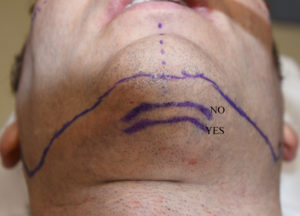A wrap around jawline implant that has been custom made is the best method for augmenting the skeletal lower third of the face. It does so because of the surface area that it covers, expanding the skeletal contours of the lower third of the face. Like all implants in the face and body, its augmentation effect requires extra soft tissue coverage which comes from overlying local tissue expansion and surrounding tissue recruitment.
For the jawline the tissue recruitment actually comes from the neck and not the face. This is why a total jawline implant actually creates a bit of neck lift which is most evident in older patients with some natural sagging skin and in younger patients with fuller or less well defined necks. While this ‘generosity’ of soft tissue is most profound in the jaw angle area, there are more limits to what happens in the chin area due to the natural tightness of the overlying soft tissue chin pad and the tighter nature of the central new tissues.
When designing a custom jawline implant considerations are always given as to how the overlying soft tissue may respond to it. While these do not play any factor in how incisions to place the implant are made inside the mouth, they do influence an anterior submental skin incision if that approach is used. (which is done so in a lot of men)

This decision to move back the location of the submental skin incision, as mentioned is based the size of the chin implant portion of the implant. When the horizontal increase is bigger than 5mms or e vertical increase is bigger than 5mms, or any combination thereof, the submental incision should be adjusted accordingly.
Dr. Barry Eppley
Indianapolis, Indiana


